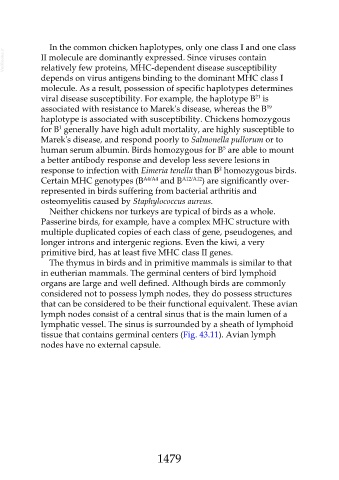Page 1479 - Veterinary Immunology, 10th Edition
P. 1479
In the common chicken haplotypes, only one class I and one class
VetBooks.ir II molecule are dominantly expressed. Since viruses contain
relatively few proteins, MHC-dependent disease susceptibility
depends on virus antigens binding to the dominant MHC class I
molecule. As a result, possession of specific haplotypes determines
21
viral disease susceptibility. For example, the haplotype B is
associated with resistance to Marek's disease, whereas the B 19
haplotype is associated with susceptibility. Chickens homozygous
1
for B generally have high adult mortality, are highly susceptible to
Marek's disease, and respond poorly to Salmonella pullorum or to
5
human serum albumin. Birds homozygous for B are able to mount
a better antibody response and develop less severe lesions in
2
response to infection with Eimeria tenella than B homozygous birds.
Certain MHC genotypes (B A4/A4 and B A12/A12 ) are significantly over-
represented in birds suffering from bacterial arthritis and
osteomyelitis caused by Staphylococcus aureus.
Neither chickens nor turkeys are typical of birds as a whole.
Passerine birds, for example, have a complex MHC structure with
multiple duplicated copies of each class of gene, pseudogenes, and
longer introns and intergenic regions. Even the kiwi, a very
primitive bird, has at least five MHC class II genes.
The thymus in birds and in primitive mammals is similar to that
in eutherian mammals. The germinal centers of bird lymphoid
organs are large and well defined. Although birds are commonly
considered not to possess lymph nodes, they do possess structures
that can be considered to be their functional equivalent. These avian
lymph nodes consist of a central sinus that is the main lumen of a
lymphatic vessel. The sinus is surrounded by a sheath of lymphoid
tissue that contains germinal centers (Fig. 43.11). Avian lymph
nodes have no external capsule.
1479

